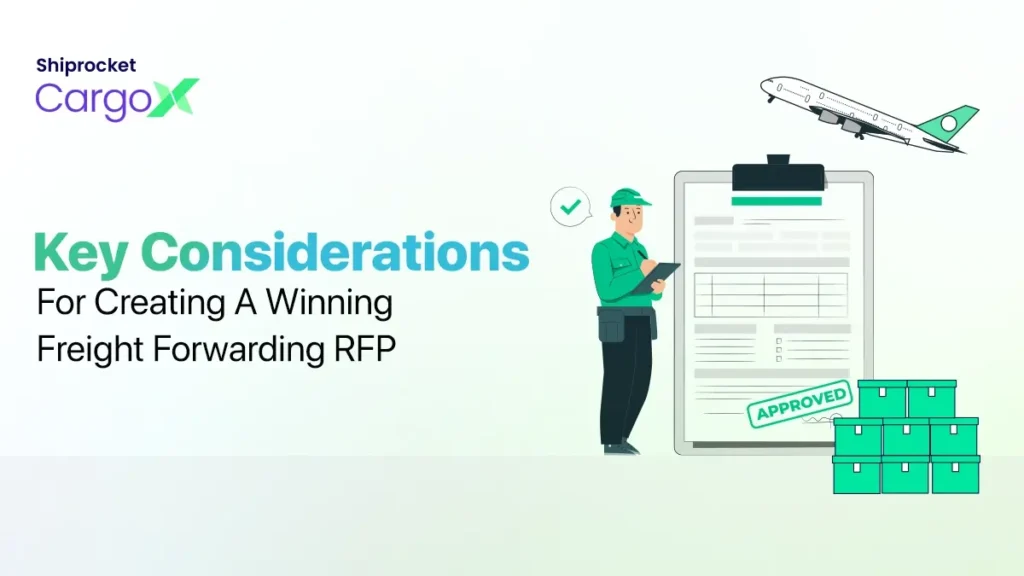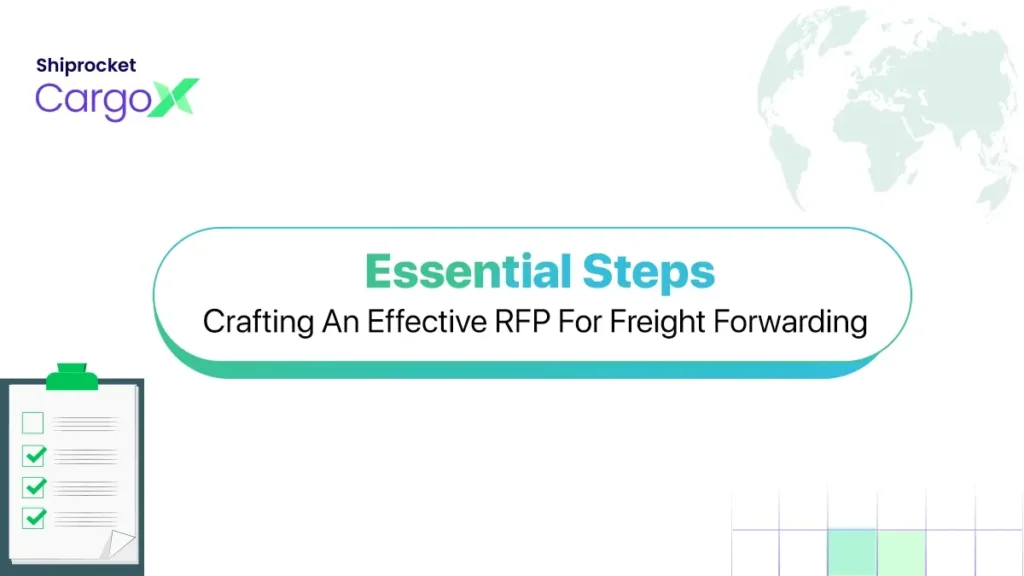How to Create a Freight Forwarding RFP for Efficient Shipping
- Understanding RFPs for Freight Forwarding
- What to Include in a Freight Forwarding RFP: Essential Components?
- How to Craft a Request for Proposal (RFP)?
- RFP Process: A Step-by-Step Guide
- KPIs to Include in Your Freight RFP
- Additional Tips for Creating Effective Freight RFPs
- CargoX: Transforming Freight Shipping with Advanced Solutions
- Conclusion
Freight forwarding is an essential task that enables the movement of goods across borders to different markets. In domestic and international shipping, the choice of the right freight forwarder can be a game changer for your business in terms of costs and timely delivery. So, when selecting a shipping partner, the initial step that should be made is creating and deploying a detailed Request for Proposal (RFP). Freight forwarding RFP is a useful tool that allows you to describe your logistical requirements to facilitate freight forwarders proposing scalable solutions.
This blog will discuss various factors that cannot be overlooked to ensure the preparation of an RFP that will help get efficient and affordable shipping services.

Understanding RFPs for Freight Forwarding
An RFP is a means of stating the logistical needs of a particular company and the process of requesting the freight forwarding companies to present their plans on how they will address these needs. Freight forwarding RFPs serve multiple purposes, including:
- Defining Service Scope: RFPs help clarify the exact logistics services and support a company needs from a freight forwarder.
- Identifying Potential Challenges: By addressing current or anticipated logistics issues in the RFP, companies can seek solutions and strategies from potential freight forwarders.
- Setting Clear Expectations: RFPs establish clear guidelines regarding budgets, timelines, and performance metrics. This allows the firm and the freight forwarder to align on goals, fostering accountability and transparency in the partnership.
An RFP enables you to assess which forwarder best matches your shipping needs. It eases your decision-making process regarding your logistics, thereby guaranteeing that your consignments are properly managed.
What to Include in a Freight Forwarding RFP: Essential Components?
To develop a successful freight forwarding RFP, you should include several critical components. This ensures clarity and facilitates accurate proposals:
- Company Overview
First, provide a brief description of your business so that readers get an idea. Provide information about the industry in which you operate, the kind of products you deal with, the average shipping rates, and your target markets. This enables freight forwarders to establish whether they have the capacity and competence to handle your shipments.
- Freight Specifications
Describe your shipment requirements, such as type of packaging, preferred means of transportation (air, sea, ground or rail) and locations where you want products to be delivered. Detail the mean weight, dimension, and volume of the shipment. In addition, mention any constraints that may be attached to the cargo, for instance, hazardous or perishable goods.
- Budget and Pricing Structure
It is crucial to disclose the budget expectations to help freight forwarders align their services to your specifications. State the amount of money you have set aside for freight services and ask for breakdown costs such as fuel charges, export duties, taxes, and customs fees.
- Succession of Events and Crucial Time Points
State your preferred time frame for submission of the proposal, the evaluation period, and the time within which the results will be made known. Also, mention any other significant dates about the real transportation, for example, project launch dates, seasonal fluctuation patterns or product release dates.
- Performance Metrics and KPIs
Specify the expectations of performance further by identifying key performance indicators that would be used in ascertaining the effectiveness of the freight forwarder. These may comprise delivery frequency compliance, damage-free shipment ratio, customs clearance effectiveness, and shipment monitoring performance.

How to Craft a Request for Proposal (RFP)?
Crafting an RFP for freight forwarding requires careful attention to detail to ensure the document is clear, comprehensive, and actionable. Here’s a guide to help you create an effective RFP:
- Define Your Business Needs: Determine what specific logistics issues are relevant to your business, including, but not limited to, cutting down the costs of shipping, delivery time, or delivery damage. Writing these needs down will ensure that you can state the extent of the services you require.
- Conduct Market Research: Identify potential freight forwarders with relevant services, core competencies, and reputation. This will help you be realistic, especially when assessing the proposals.
- Be Precise and Transparent: It is vital to achieve precision when writing an RFP. Shipment volumes, routes, and any special cargo handling needs must be disclosed to request direct and specific information. Disclosure of timelines, cost estimates, and expected performance levels is helpful to ensure that freight forwarders’ offers are reasonable.
- Arrange the RFP for Ease of Review: Proper headings, sections, and bullet points should provide a clear and logical structure to the RFP so that potential vendors can easily find their way through the document and answer the questions that have been set. An organised document reduces the time taken to ask for proposals and ensures that you get quality proposals.
RFP Process: A Step-by-Step Guide
The RFP process involves several stages, each crucial for ensuring a smooth and successful collaboration with the right freight forwarder. Here’s a breakdown of the steps:
- Draft the RFP Document: It’s advisable to start by compiling all data from your insiders, such as your logistics, finance, and operations departments. This ensures that your RFP complies with your shipping requirements and the extent of your budget.
- Distribute the RFP: Submit the completed RFP to short-listed freight forwarders. Ensure these companies are competent in managing consignments of different sizes and weights and meet your requirements.
- Evaluate Proposals: Upon submission of the proposals, evaluate each depending on the criteria you have set. As such, you can compare the freight forwarders based on the pricing model, services offered, the KPIs used, and their effectiveness in managing your logistics needs.
- Shortlist Potential Partners: Filter the list of possible freight forwarders according to your requirements and budget. At this stage, it may also be a good idea to schedule follow-up meetings or interviews to review details.
- React to Partners and Investors and Finalise the Contracts: Once you have identified your preferred freight forwarder, engage with them in price negotiations to agree on the final rate, service deliverables, and timeframes. Make sure that all the KPIs and service expectations are well spelt out in the final contract.
KPIs to Include in Your Freight RFP
Including KPIs in your freight forwarding RFP ensures that your chosen freight forwarder is accountable for meeting performance standards. Important KPIs to consider are:
- On-Time Delivery Rate: Assess the freight forwarder’s level of compliance with the set timeline for the delivery of shipments.
- Damage-Free Delivery: Monitoring the percentage of undamaged goods received provides insights into freight forwarders’ handling practices and overall care during transportation.
- Cost Efficiency: Keep an eye on the overall cost per shipment and any extra surcharges the freight forwarders charge to determine if they are a cost-effective service.
- Customs clearance success rate: Check how the freight forwarder manages customs documentation and procedures to minimise delay and penalties.
Additional Tips for Creating Effective Freight RFPs
To further ensure your freight forwarding RFP is comprehensive and effective, consider the following tips:
- Use Accurate Shipping Data: This is because providing accurate data helps freight forwarders in making reasonable proposals. It is important to have the correct information about the consignment size, mass, and measurements.
- Make the Price Competitive: Request the freight forwarders a breakdown of the price per minute, day, or month and any additional charges that may be incurred. This will assist in properly drawing comparisons between various vendors.
- Be Open to Innovations: While setting clear expectations is important, being receptive to new ideas and innovative approaches from freight forwarders can help improve services and cost savings. Encouraging them to propose strategies or technologies can enhance efficiency and improve overall logistics solutions.
CargoX: Transforming Freight Shipping with Advanced Solutions
CargoX revolutionises freight forwarding to provide business ventures with sophisticated logistics solutions. It is a smart shipping platform that utilises technology and guarantees on-time delivery of goods with real-time visibility into shipments. CargoX has features that allow it to handle international shipments with ease.
It offers tailored shipping plans for businesses, enabling them to ship within their budget. Through this CargoX partnership, companies will likely experience enhanced performance and seamless value chain delivery.
Conclusion
When looking for a logistics partner to support your business’s shipping process, developing an effective freight forwarding RFP is crucial to help you make the right decision. With elements like shipping specifications, expected performance, and KPIs, it will be easier to work on the proposal and choose the best freight forwarder. Companies need no longer worry about freight management; solutions like CargoX can help businesses elevate their shipping services.





